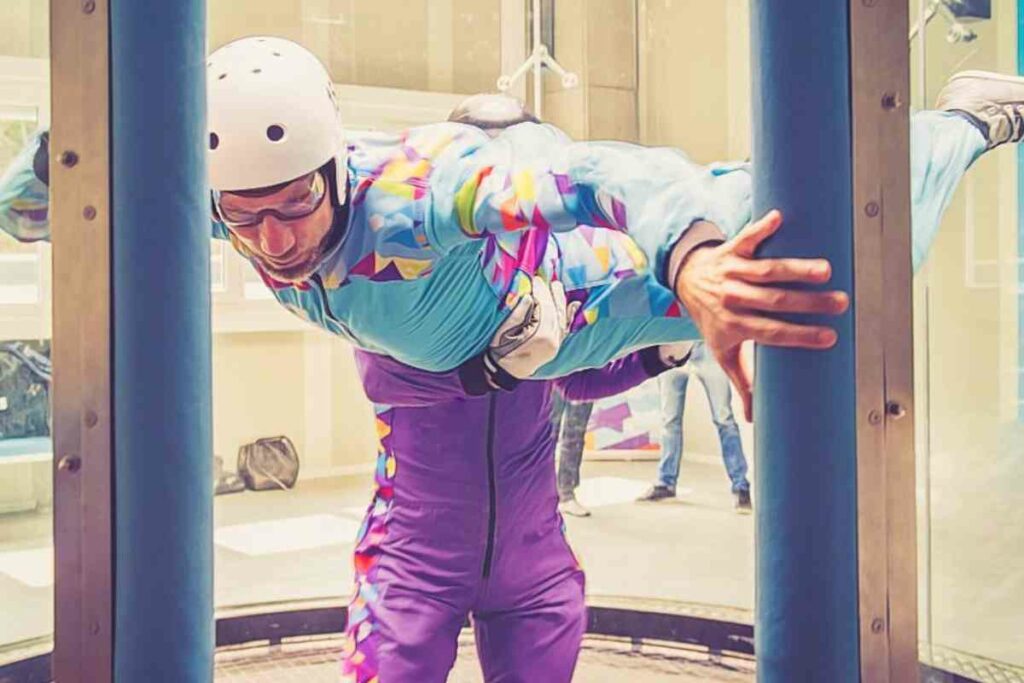If you’re considering watching one, you may wonder, how do judges score indoor skydiving competitions, anyway?
This is a good question, and it will certainly help keep the competition more interesting to watch.
In order to learn how judges score the competitions, you’ll need to learn a little bit about the sport, i.e. types of skydiving, along with what judges look for!
FS (Formation Skydiving)
The main type of skydiving is formation skydiving, which focuses on both precision and speed!
You can expect to see a great deal of this at most indoor skydiving competitions (with the exception of a freestyle competition).
As its name implies, formation skydiving entails 2-4 skydivers going in and out of different formations. They’re given a point per successful formation. Usually, two or more teams are placed head to head!
Read before you go – Can You Indoor Skydive If You Have a Medical Condition?
Type of Round
So, how do judges score indoor skydiving competitions? What types of indoor skydiving rounds are there?
There are just a couple. These are the speed round and the freestyle/artistic round.
Speed Round
First off, we have speed rounds. This applies to basically any FS (formation skydiving) round, as they’re all primarily judged on speed.
How fast do they go through the movements, and do they meet the time limit? This is what judges will ask! This differs greatly from freestyle/artistic rounds, as you’ll soon find!
Are you exploring indoor skydiving as a beginner? Delve into the world of indoor skydiving armed with knowledge and useful tips from this detailed beginner’s guide.
Freestyle/Artistic Round
Freestyle and artistic rounds are relatively new to the indoor skydiving world.
Unlike FS skydiving, they involve just one indoor skydiver! This skydiver comes up with their own, unique routine (combined with a few compulsory, i.e. required formations).
Instead of focusing on speed, these routines are based on dynamics and creativity.
- What unique moves can the indoor skydiver come up with?
- Do they perform them with grace and speed?
- Are they new?
These are the sort of questions indoor skydiving judges will ask!
What Judges Consider
When it comes to indoor skydiving, as with any sport, there are some specific things that judges will pay close attention to and consider.
For example:
- Technical difficulty. Perhaps the main thing judges score indoor skydiving competitions on is the technical difficulty. Basically, this means that they rate competitors based on raw skill!
- Precision. Once the judges see what you’re capable of, they see how well you do it. How precise are your movements? How smoothly do you flow from one to the other? Are there any hiccups, or are you quite graceful? All of these are things the judges will ask!
- Dynamics/creativity. Depending on the type of indoor skydiving (speed or freestyle), there’s a bigger or smaller focus on dynamics/creativity. While this can be a plus for speed rounds and FS rounds, it’s much more critical for freestyle/artistic rounds. In fact, it makes up a great deal of the score in the latter!
- Synchronization. In FS, synchronization is practically everything. Every move you make, you make together! You can’t carry the team, or make allowances for a slower/less skilled team member. The judges will surely see this, and score accordingly. This means that everyone must be on track!
- Speed. Any experienced indoor skydiver can go through the formations… the question is, how quickly can they do it? How fast can they do a formation routine in total? The faster the better!
Penalties (Lost Points)
Next, we have the penalties, i.e. the things that will lose an indoor skydiver points.
Some of these are:
- Incorrect patterns. Unfortunately, if a competitor slips up on a pattern, the judges will notice. The patterns must be exact, or the competitor will be penalized. The penalty is usually the loss of 1 point, just as the reward for a correct pattern is 1 point (nice and simple).
- Missing or skipping a move. If you entirely miss a move, as you can probably imagine, this will hurt your score. It’s important that you don’t miss anything, or it will throw the rest of your team off!
- Crashing (especially intentionally). Crashing is a big ‘no-no,’ in indoor skydiving competitions. This goes doubly if you do it consciously. Why would a team intentionally crash? To save time, simply put. Unfortunately for teams that try this, judges can almost always tell!
- Omitted compulsory. In most competitions, there are compulsory forms and forms your team can choose from. If you omit any of the compulsory forms, the judges will notice, and penalize you accordingly. This is definitely something to avoid!
Final Words
So, there you have it. Like any sport, indoor skydiving has rewards, penalties, and all of the classic stuff.
There are a couple of different kinds of indoor skydiving, i.e. speed and freestyle/artistic, and these are judged a bit differently. A point is awarded per successful form, or a point is taken away if you are penalized. So, now you know!







